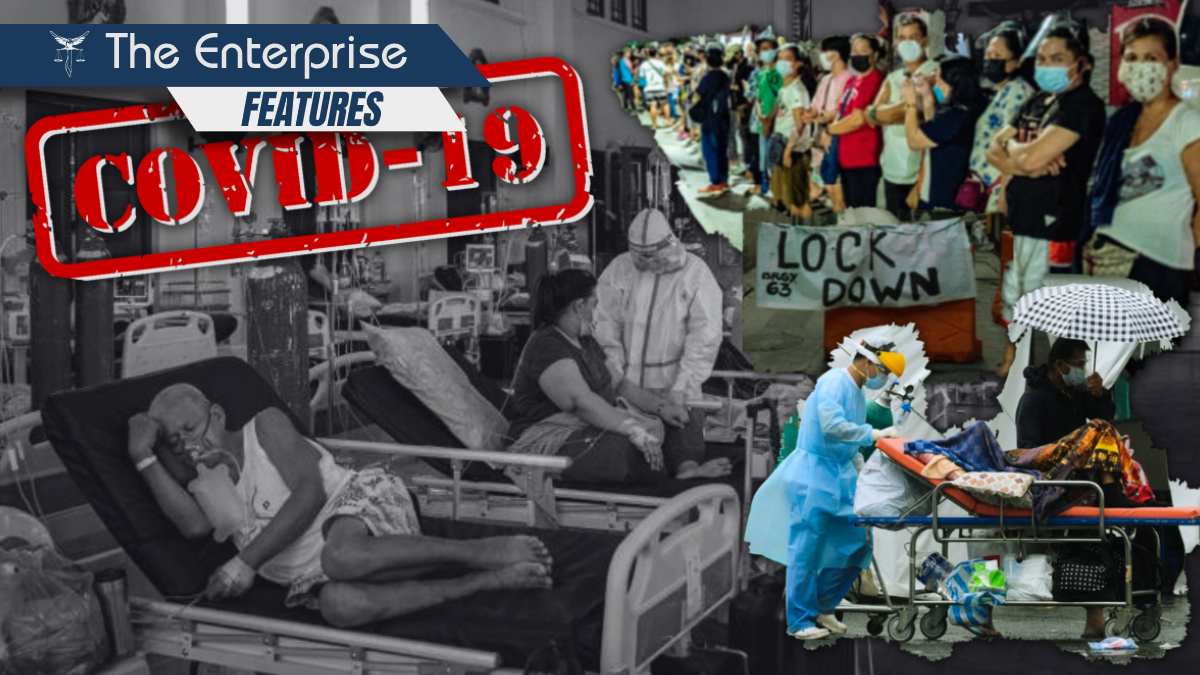
Pinoy Baiting: An Online Virus to Beat
September 29, 2021
Are Online Classes Worth It?
October 13, 2021State of Infection: Last Man Standing

Now that other countries have started to open up and rebuild their economies, this could be a sign that the Philippines will follow suit. However, the fight against COVID-19 drags on without any certainty of its end. The routine vaccinations, lockdowns, and wearing of both face masks and shields have been in the policies for a long time now. The number of cases, even with the continuous arrival of vaccines, still increases each day. Would the country ever find the end of this fight even after all these efforts? Let us now look back and take our time browsing notable events that happened in the past three months.
Pinch of Solace
July 5
In the latest resolution of the Inter- Agency Task Force (IATF), Reverse Transcription Polymerase Chain Reaction (RT-PCR) tests were no longer required for fully vaccinated travellers.
July 6
Sec. Carlito Galvez Jr., Chief Implementer of the National Task Force Against COVID-19 and vaccine czar, said that 2.5-M doses of Sinovac vaccines were expected to arrive in the third week of July.
On the other hand, hundreds of seafarers in Taguig City were vaccinated against COVID-19. In line with this, Taguig Local Government Unit (LGU) was also preparing for the onset of inoculation for the private sector.
July 9
Children above five years old in General Community Quarantine (GCQ) and Modified General Community Quarantine (MGCQ) areas were allowed to go out in selected places; malls were still exceptions.
132,200 doses of Sputnik V vaccine have arrived in the Philippines.
July 10
OCTA Research group said that COVID-19 situation in the whole country and even in Metro Manila was under moderate-risk. In addition, loosening restrictions in the National Capital Region (NCR) would be feasible if 20-40% of the region was fully-vaccinated.
Today, 5,675 new COVID-19 cases were recorded, pushing the tally to 1,467,119 total confirmed cases.
July 14
July 16-31 travel ban for Indonesia will be implemented as precaution against the spread of Delta variant in the Philippines.
OCTA Research group called for prioritization for the inoculation of NCR Plus 8.
Meanwhile, Malacañang assured that the country was ready for the possible intrusion of the Delta variant.
562,770 doses of Pfizer vaccine have arrived in the country.
July 22
Deputy Chief Implementer Sec. Vince Dizon said that 16-M doses of COVID-19 vaccines had been administered.
1.5-M Sinovac vaccines have arrived in the Philippines, pushing the total vaccines received to 29,985,130.
Much Tough Fight with the Intruder
July 28
Philippine Chamber of Commerce and Industry, Exporters Confederation of the Philippines, and Federation of Filipino Chinese Chambers of Commerce and Industry proposed an imposition for a lockdown due to the surge of the Delta Variant cases. The increase in restrictions “will decrease the number” of the said virus. The proposal for the government was also supported by Joey Concepcion, a Presidential Adviser for Entrepreneurship, who claimed that August will be the best month to impose a harsh restriction.
July 29
Delta Variant of COVID-19 cases rose to 216 after the addition of 97 detected cases.
GCQ with heightened restrictions in NCR was extended until August 15.
August 2
Hospitals in NCR were on a high alert level brought by the more contagious Delta variant.
Presidential Spokesperson Sec. Harry Roque said that each family in Enhanced Community Quarantine (ECQ) areas could receive P1,000 to P4,000 financial assistance.
August 3
President Rodrigo Duterte personally welcomed the arrival of Moderna vaccines donated by America.
Roque has announced that Authorized Persons Outside Residence (APORs) will receive complimentary train rides to aid in their transportation.
August 6
10,623 new COVID-19 cases were recorded, the highest record since April’s surge of Alpha variant.
Restrictions were imposed to passengers; only Authorized Persons Outside Residence (APORs) were allowed to travel, Department of Transportation (DOTr) Spokesperson Asec. Goddes Hope Libiran said.
August 10
FDA assured that the supply of oxygen tanks in the country was adequate.
Children 12 years old and above might be considered for vaccination once sufficient percentage in the priority groups has been vaccinated, Pediatric Society of the Philippines and Pediatric Infectious Disease Society of the Philippines stated in a joint statement.
August 13
More than 42-M total COVID-19 vaccine doses have arrived in the Philippines, 26.15-M of which were bought by the government and private sectors while 15.91-M doses came from donations.
Undervalued Heroes’ Objection
August 16
The Delta variant of 807 reported cases was considered as the top variant in the country, the Department of Health (DOH) said.
Meanwhile, mass resignation was eyed by some health care workers in 10 big private hospitals in Metro Manila to be enjoined by public hospitals in the country as a protest for delayed benefits.
August 21
Pres. Duterte ordered the DOH to pay the overdue allowances of health care workers.
August 23
Metropolitan Manila Development Authority (MMDA) said that 43% of the target population in NCR were fully-vaccinated.
Moreover, more than 13-M Filipinos were fully-vaccinated, which were 17% of the eligible population for the vaccine, NTF said.
August 25
The Department of Budget and Management (DBM) provided the DOH with P311 million. Hazard pay has been paid to 20,156 healthcare workers.
August 30
22,366 new COVID-19 cases set the record as the highest tally ever since the pandemic started.
In addition, 74% of the ICU in the whole country was full according to DOH.
September 1
The MU variant of SARS COV-2, which has effects against the efficacy of vaccines, and the C.1.2 variant from South Africa were being monitored by the World Health Organization (WHO).
September 5
Interior Sec. Eduardo Año said that pilot testing of granular lockdown in NCR on September 8 would be possible.
On the other hand, Vice President Leni Robredo said she was ready to help in managing the COVID-19 response; however, she couldn’t unless given an authority.
September 8
Pres. Duterte took full responsibility in his order to Sec. Duque to buy medical supplies in the fastest way possible.
September 11
26,303 new COVID-19 cases were recorded pushing the tally to 2,206,021 of which 185,706 remained active.
Vaccine registrations for 12 to 17 years old were finally opened in some LGUs.
According to Finance Secretary Carlos Dominguez III, the Philippines requires 9 million vaccine doses per week to meet its goal. However, the Philippines received only 3.5 million doses due to “delivery complications” by pharmaceutical companies.
September 13
Today, the resumption of the free rides prioritizing health and medical frontliners, essential workers, and Authorized Persons Outside of Residence happened where Filipinos wait in line at Kamuning Bus Stop in Quezon City.
On this day, the national government mandated guidelines for a new Alert Level and Granular Lockdown System of which Roque announced later that day. The alert level system is meant to improve and replace the existing quarantine classification system and is more lenient in terms of age mobility restrictions and provides some benefits to individuals who are fully vaccinated.
September 14
Another dreadful news—Año announced that Metro Manila will be under general community quarantine with alert level 4 when the region shifts to a new lockdown scheme on September 16.
It is the same day when the DOH corrected Roque on the government’s supposed decision to allow health workers to receive a third COVID-19 shot. They said that the DOH All Experts’ Group together with the DOH is still carefully deliberating and no final recommendation from the experts yet.
September 17
Malacañang announced updates to its list of countries under “red,” “green,” and “yellow” travel lists. The new classification takes effect from September 19 to 30.
• Red list countries – travelers from these countries are not allowed to enter on a given timeframe
• Green list countries – fully vaccinated travelers from these countries will have shortened quarantine period upon arrival and have RT-PCR during their fifth day
• Yellow list countries – fully vaccinated travelers must still do a 14-day quarantine with an RT-PCR test on the seventh day of quarantine
September 18
According to Health Secretary Vergeire, hospitals need to report bed availability data more quickly so that the DOH can generate a more accurate picture of hospital capacity.
This is in response to a statement by the Alliance of Healthcare Professionals Against COVID-19, which said that the DOH uses bad metrics and cannot accurately report how overwhelmed the healthcare system is.
September 19
The Philippines now has 2,366,749 confirmed COVID-19 cases after the DOH reported 19,271 new cases, 205 new deaths, and 25,037 recoveries. This day was the sixth straight day that over 200 deaths were reported.
September 24
The national government will allow candidates, their companions, certain political party leaders, and Commission on Elections (COMELEC) officials and personnel to leave their homes for the filing of candidacies from October 1 to 8.
On the same day, the pandemic task force signed Resolution No. 140 which recognizes the following as authorized persons outside of residence (APORs) during the filing week.
September 25
Vergeire encouraged the public to view the seeming downtrend in COVID-19 cases “cautiously,” as it could have been affected by fewer tests conducted by laboratories. This is because out of the 6,000 antigen tests they examined, only around 300 were found to be used according to their purpose.
September 28
Health officials are closely monitoring the COVID-19 indicators to show that the situation of the epidemic in the Philippines may be easing after months of a steep increase in infections. Still, health systems continue to struggle and several areas still report spikes in infections.
September 29
Health Undersecretary Myrna Cabotaje says that the rollout of vaccines to minors with comorbidities may start as early as October 15, with a pilot run in Metro Manila.
September 30
As this month ends, DOH reported 14, 286 new confirmed cases making the total cases of the country to have 2,549,966. In addition, 130 new deaths and 8,268 recoveries were recorded.
We’ve been through several ups and downs in this battle of the world against one but deadly enemy. What the restrictions and guidelines were from day one are still the same standards we’ve been following for 18 months and counting. Resuming some of the ‘old normal’ activities during pre-COVID might give false hope to the people that the virus is nearly being conquered. We are nowhere near the end but now we hold knowledge that we didn’t have before. It is high time for us to do our part as the government does theirs. Cooperation will bring us to what we’re aiming to attain—calmness after the long tiring waves.
LAYOUT BY: Alexandra Briones
PHOTO SOURCE(S): Eloisa Lopez, Reuters


